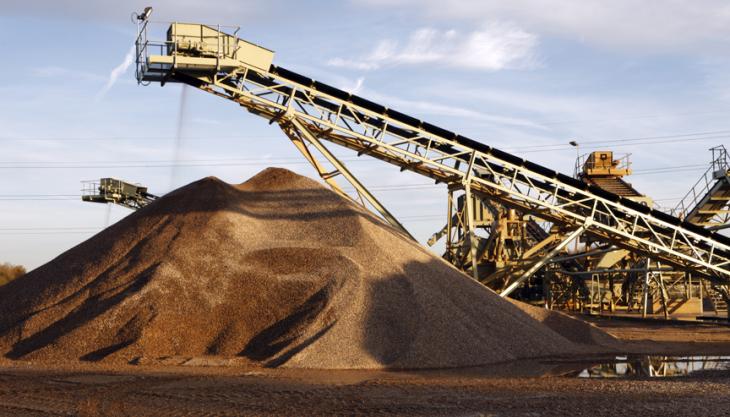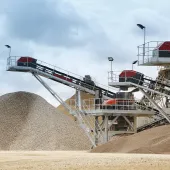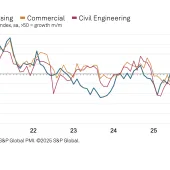Materials producers supply record volumes in Q2 2021

Industry delivers highest quarterly volumes of heavy-side mineral products in more than 12 years
DELIVERED volumes of heavy-side mineral products broke records in the second quarter (Q2) of 2021, pointing to robust construction and manufacturing activity despite reports of material and staff shortages. The latest quarterly survey from the Mineral Products Association (MPA) shows that, in recent months, the industry has supplied the highest quarterly volumes of materials such as aggregates and asphalt in more than 12 years.
The MPA believes this strong growth in material demand shows that recovery in construction is intensifying, despite ONS data suggesting that construction output slowed in April and May. And since heavy-side materials tend to be used early in building projects – for foundations and core structures – the figures suggest that construction will remain buoyant for at least the next few months.
For aggregates, although sales of primary crushed rock, sand and gravel recorded a small decline of 0.4% in Q2 2021 compared with Q1, the first half of 2021 saw aggregates sales volumes at their highest since mid-2008. Aggregates sales have recovered rapidly in the past year, boosted by demand for bulk fill materials on major infrastructure projects and highway schemes.
Asphalt sales volumes rose by 4.5% on a quarterly basis in 2021 Q2 to more than 6 million tonnes, the second highest volume recorded since 2008 (the highest was in Q4 2020). Pent-up demand from delayed roads projects due to the pandemic, wider progress on the delivery of the Government’s road investment strategy, and an increase in demand from local authorities for repair and maintenance work, all resulted in an unexpectedly rapid recovery in activity. Total demand for asphalt in the year to June 2021 was 4.0% higher than in 2019, with demand particularly strong in Scotland and the East Midlands.
In mortar sales, which closely reflect house building activity, volumes rose at their second-fastest quarterly rate of growth since 2012, up by 21.2%, although some of that is likely to be a ‘catch-up’ from the impact of adverse weather at the start of the year. Growing momentum in mortar sales is evidence of new house building activity starting, rather than the completion of existing developments. This indicates a renewed pipeline of work for other sectors of the construction supply chain over the next few months.
In contrast, market conditions for ready-mixed concrete remain weak. Concrete sales volumes increased by 1.2% from Q1 to Q2 but a comparatively slow recovery since last year means that volumes on an annual basis are significantly down compared with 2019, particularly in London and the South East. Whilst demand from industrial projects is strong, with the building of new distribution centres for online retailers, the biggest driver of activity is infrastructure, especially with work increasing on HS2. However, demand from office and retail developments is weak as the sector is still coping with the cumulative effects of four years of Brexit-related uncertainty, compounded by the ongoing impact of the pandemic.
The MPA anticipates that demand for core construction materials will remain high for the remainder of this year and into 2022. The outlook for construction, and in particular infrastructure, is expected to drive double-digit growth in mineral products sales through 2021 with further, albeit more muted, growth in 2022.
Aurelie Delannoy, the MPA’s director of economic affairs, said that pressures felt in other sectors of the economy were also impacting mineral products manufacturers: ‘The surge in pent-up demand for materials in recent months, plus declining availability of haulage drivers as well as increasing costs are causing concerns over future supply capacity, although every effort is being made to mitigate these. Despite challenging circumstances, companies supplying mineral products have, on the whole, continued to meet the demands, delivering record volumes along the way.’
Nigel Jackson, chief executive of the MPA, said: ‘The mineral products sector has performed valiantly over the first half of 2021 despite all the challenges and uncertainties, the currently avoidable ‘pingdemic’ being but one. There has been much talk about ‘what has not been supplied’, for example bagged cement in some areas, but this really needs to be seen in perspective – the vast majority of this year’s unprecedented demand for materials has been met. The issue has been more about keeping up with excess demand at a time when seasonal stocks are usually low, whilst scheduled plant maintenance normally planned for quieter periods was out of ‘sync’ with the sudden surge in activity.
‘Bearing in mind that we’re an industry that typically supplies a million tonnes of materials every day, there are bound to be a few strains in the supply chain. Eventually, the collision between increased material demand, a perpetually under-resourced mineral planning system and under-replenished mineral reserves will hit home. Sooner or later, this will have to be addressed and with far more innovative thinking than we’ve seen with the latest review of the planning bill, which will do nothing to help the country sustain a supply of essential mineral products.’









